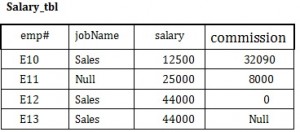8.4: Nulls
- Page ID
- 92181
A null is a special symbol, independent of data type, which means either unknown or inapplicable. It does not mean zero or blank. Features of null include:
- No data entry
- Not permitted in the primary key
- Should be avoided in other attributes
- Can represent
- An unknown attribute value
- A known, but missing, attribute value
- A “not applicable” condition
- Can create problems when functions such as COUNT, AVERAGE and SUM are used
- Can create logical problems when relational tables are linked
NOTE: The result of a comparison operation is null when either argument is null. The result of an arithmetic operation is null when either argument is null (except functions that ignore nulls).
Example of how null can be used
Use the Salary table (Salary_tbl) in Figure \(\PageIndex{1}\) to follow an example of how null can be used.

To begin, find all employees (emp#) in Sales (under the jobName column) whose salary plus commission are greater than 30,000.
SELECT emp# FROM Salary_tbl
WHERE jobName = Sales AND
(commission + salary) > 30,000 –> E10 and E12
This result does not include E13 because of the null value in the commission column. To ensure that the row with the null value is included, we need to look at the individual fields. By adding commission and salary for employee E13, the result will be a null value. The solution is shown below.
SELECT emp# FROM Salary_tbl
WHERE jobName = Sales AND
commission > 30000 OR
salary > 30000 OR
commission + salary) > 30,000 –>E10 and E12 and E13

